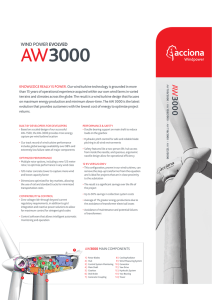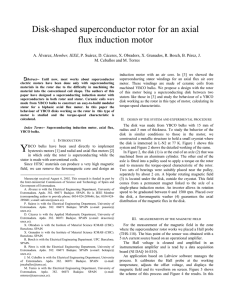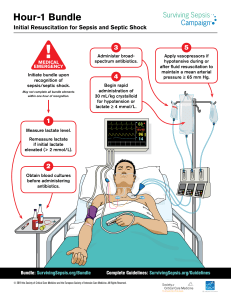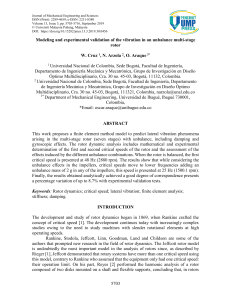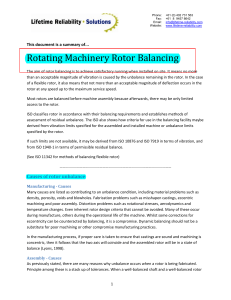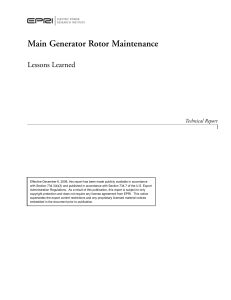STUDY ABOUT THE METABOLIC EFFICIENCY OF THE ROTOR
Anuncio
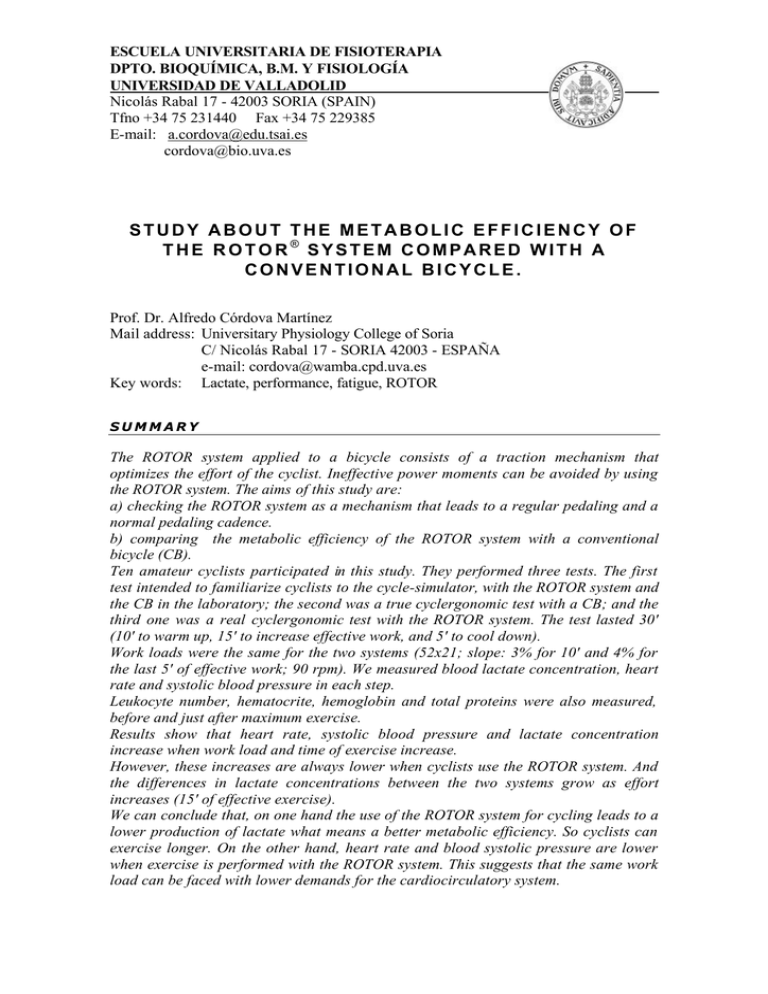
ESCUELA UNIVERSITARIA DE FISIOTERAPIA DPTO. BIOQUÍMICA, B.M. Y FISIOLOGÍA UNIVERSIDAD DE VALLADOLID Nicolás Rabal 17 - 42003 SORIA (SPAIN) Tfno +34 75 231440 Fax +34 75 229385 E-mail: [email protected] [email protected] STUDY ABOUT THE METABOLIC EFFICIENCY OF THE ROTOR® SYSTEM COMPARED WITH A CONVENTIONAL BICYCLE. Prof. Dr. Alfredo Córdova Martínez Mail address: Universitary Physiology College of Soria C/ Nicolás Rabal 17 - SORIA 42003 - ESPAÑA e-mail: [email protected] Key words: Lactate, performance, fatigue, ROTOR SUMMARY The ROTOR system applied to a bicycle consists of a traction mechanism that optimizes the effort of the cyclist. Ineffective power moments can be avoided by using the ROTOR system. The aims of this study are: a) checking the ROTOR system as a mechanism that leads to a regular pedaling and a normal pedaling cadence. b) comparing the metabolic efficiency of the ROTOR system with a conventional bicycle (CB). Ten amateur cyclists participated in this study. They performed three tests. The first test intended to familiarize cyclists to the cycle-simulator, with the ROTOR system and the CB in the laboratory; the second was a true cyclergonomic test with a CB; and the third one was a real cyclergonomic test with the ROTOR system. The test lasted 30' (10' to warm up, 15' to increase effective work, and 5' to cool down). Work loads were the same for the two systems (52x21; slope: 3% for 10' and 4% for the last 5' of effective work; 90 rpm). We measured blood lactate concentration, heart rate and systolic blood pressure in each step. Leukocyte number, hematocrite, hemoglobin and total proteins were also measured, before and just after maximum exercise. Results show that heart rate, systolic blood pressure and lactate concentration increase when work load and time of exercise increase. However, these increases are always lower when cyclists use the ROTOR system. And the differences in lactate concentrations between the two systems grow as effort increases (15' of effective exercise). We can conclude that, on one hand the use of the ROTOR system for cycling leads to a lower production of lactate what means a better metabolic efficiency. So cyclists can exercise longer. On the other hand, heart rate and blood systolic pressure are lower when exercise is performed with the ROTOR system. This suggests that the same work load can be faced with lower demands for the cardiocirculatory system. ESCUELA UNIVERSITARIA DE FISIOTERAPIA DPTO. BIOQUÍMICA, B.M. Y FISIOLOGÍA UNIVERSIDAD DE VALLADOLID Nicolás Rabal 17 - 42003 SORIA (SPAIN) Tfno +34 75 231440 Fax +34 75 229385 E-mail: [email protected] [email protected] INTRODUCTION One of the main aims when a muscular effort is to be carried out is achieving the lowest power consumption and maximum power efficiency. Multiple interactions among the regulating processes that keep organism's homeostasis occur during exercise(2, 6, 9, 16). One of the most important metabolic adaptations resulting from the activity during exercising or raining is the variation that occurs in the use of aerobic and anaerobic metabolism(1). The transport of the adequate amounts of oxygen and other necessary substances towards skeletal muscles is a process of great importance during endurance exercising, below-maximum efforts and/or maximums involving maximum VO2 intensities(2,6,9). Therefore, some local and general adaptations must take place in order to favor the delivery of those substances to the muscle in activity(1, 3, 16). The amount of oxygen arriving at the muscle is enough to keep to its needs when exercising at a stabilized pace(1, 11). However if aerobic metabolism becomes insufficient, lactic acid (lactate) starts forming in the muscle quicker than blood can withdraw it from there. Under these conditions, the lactate accumulation will depend on exercise duration and the constant intensity of effort (1, 3, 4, 11, 19). In normal conditions, with any conventional bicycle (CB), it can be appreciated that lactate production increases as load and exercise duration are raised. The ROTOR system applied to bicycles is a traction device that optimizes cyclists’ effort. The ROTOR system design avoids FIGURE 1: A comparison of the ROTOR pedaling cycle with the conventional system (CB). dead centers when pedaling (when cyclists’ effort is not efficient -being legs limited in their movement, they cannot perform a natural and more efficient movement-) and therefore avoids those points with no power delivery (fig. 1). The ROTOR system makes pedals independent, and synchronizes them by means of four elliptic (or off-centered) gears, so that the relative angles between pedal rods vary during the cycle. The producers of the system have obtained efficiency increases of about a 20% during their mechanical testings. It is reasonable thinking that with the ROTOR system a metabolic improvement could be obtained over the CB. We believe lactate production, as indicative of the metabolic cost, to be an informative way to measure the efficiency of a bicycle model(1, 14, 15, 19). ESCUELA UNIVERSITARIA DE FISIOTERAPIA DPTO. BIOQUÍMICA, B.M. Y FISIOLOGÍA UNIVERSIDAD DE VALLADOLID Nicolás Rabal 17 - 42003 SORIA (SPAIN) Tfno +34 75 231440 Fax +34 75 229385 E-mail: [email protected] [email protected] Taking all these physical and mechanical antecedents into account, and considering that the ROTOR system might show some metabolic improvements over the conventional pedaling system, we have intended our study: a) to check out if the ROTOR system allows for a steady pedaling and a normal pedaling cadence. b) to compare the metabolic efficiency of the ROTOR system with that of a CB, evaluating if there are metabolic improvements under the same work load conditions, measuring lactate production and heart rate. EQUIPMENT AND METHODS Ten (n=10) amateur cyclists have participated in the tests, who were at a medium degree of training, whose characteristics are reflected on Table I. Age (years) Weight (kg.) Height (cm.) VO2 max. (ml.kg-1 min-1) Table I.- Physical characteristics of the cyclists. 18.9 + 1.6 66.8 + 3.4 177.8 + 3.9 58.9 + 4.7 In order to being able of comparing the metabolic efficiency of the ROTOR system with that of the CB, we have used the Cateye GS-1000 ergometer, which allows the use of both bicycles: ROTOR and CB (each cyclist's bicycle). We have adjusted the ROTOR bicycle's saddle both vertically and horizontally in order to keep the same angles that each cyclist uses on his bicycle. The same transmission ratios (52x21), the same pedaling cadences (90 rpm) and the same rear wheels have been used on both bicycles, and the same resistance levels (3% and 4%) (slope degrees offered by the Cateye GS-1000 ergometer) at the different moments of the test. Concerning analytical valuations, we have used a self-analyzer for blood results (Coulter Electronics Ltd.) and bio-chemical ones (Hitachi 705). Lactates measuring was carried out with a YSI system, type 1,500 Sport. Heart rate was controlled with a pulsometer (Polar Sport Tester). Methods: The day before the tests, the cyclists were called to a meeting at the laboratory, in order to let them know the purpose of the study and to make an exploration of their health condition, including an electrocardiogram (ECG) and a spirometer test. Blood samples of each cyclist were also taken during this first contact, in order to perform biochemical and hematological tests afterwards. This way we were able to know the biological status of each participant, discarding those ones which could present some pathology. The tests were performed in three sessions (in different days for each participant): a) the first laboratory test with the only purpose of getting used to the ergometer, the ROTOR system and the CB. b) the second test was a real cycloergometric measuring with the CB. c) and the third one was a real cycloergometric measuring session with the ROTOR system. The content of the real measuring sessions, for both the CB and ROTOR, was a 30' long continuous test. These 30' included a 10' warm up, after which the transmission ratio and ESCUELA UNIVERSITARIA DE FISIOTERAPIA DPTO. BIOQUÍMICA, B.M. Y FISIOLOGÍA UNIVERSIDAD DE VALLADOLID Nicolás Rabal 17 - 42003 SORIA (SPAIN) Tfno +34 75 231440 Fax +34 75 229385 E-mail: [email protected] [email protected] resistance levels above mentioned were set up (52x21, 3% and 4%), 10' at a slope of 3%, and 5' at a slope of 4%, at 90 rpm, with five final minutes to cool down -pedaling without load-. Arterial blood samples (obtained with a pricking lancet) were collected in order to evaluate lactate concentration at five different steps: after the warm-up, and 5', 10', 15' after it, and after the cooling down. Venous blood samples were also collected from around the elbow joint, at rest and immediately after maximum effort, so that the following hematological variables were determined: hemoglobin, hematocrite and total proteins. During the whole testing protocol, the individuals were kept monitored in order to get their electrocardiographic profile (BOSCH), their heart rate and arterial tension at every predetermined step. The use of the present testing protocol is based on the fact that this is a sub-maximum test, which is nearest to reality in case normal individuals use a bicycle for leisure time activities. Beside this fact, the election of a 30' long test (15' of effective effort) is made because under these circumstances, the individual uses his glycogen stock fundamentally. If the limit of 30-35 minutes is stepped over, other organic substances become involved (4, 11, 19). Therefore, trying to reproduce as much as possible the conditions given in leisure time activities, we renounced to implementing a maximum effort test for a longer testing time. STATISTICAL ANALYSIS The presented data are the arithmetical mean (the average) of the results at each moment (i.e. after warm-up, 5', 10', 15' and after cooling down period) for the following parameters: lactate, heart rate and systolic arterial pressure (SAP), for both the CB and the ROTOR bicycles. These data allow a complete study of the evolution of each variable for each system. The data on leukocytes, hematocrite, hemoglobin and total proteins are shown as average of the differences at each moment, that is, before and after exercising for each variable (coupled data) and for each system. RESULTS Figures 2 (lactate), 3 (heart rate) and 4 (systolic arterial pressure) refer to the metabolic aerobicanaerobic and cardiocirculatory behavior at the different stages (warm-up, 5', 10', 15' and cooldown) for each one of the tests (CB: continuous line; ROTOR: discontinuous line). In these three figures a similar physiological behavior for both systems can be appreciated. That is to say, as exercise time and effort load increase, heart rate is increased (Fig. 3) along with SAP (Fig. 4) and there is a subsequent lactate production increase (Fig. 2). However, outcomes for ROTOR are always lower than those of the CB, and the gap gets broader as effort level increases (15' of exercise). With regard to the informative parameters on the homeostatic variations produced by the exercise, corresponding data are shown on table 2. These data are not shown as absolute values of the variables, but as average of the differences existing between the value before exercising and immediately afterwards. This type of presentation has been chosen because each individual has different previous and subsequent values of the body variables associated to his organism. And if we had simply considered the averages of the values before and after the test, the real variations ESCUELA UNIVERSITARIA DE FISIOTERAPIA DPTO. BIOQUÍMICA, B.M. Y FISIOLOGÍA UNIVERSIDAD DE VALLADOLID Nicolás Rabal 17 - 42003 SORIA (SPAIN) Tfno +34 75 231440 Fax +34 75 229385 E-mail: [email protected] [email protected] between the values of the variable before and after the exercise could have escaped unnoticed easily because of data dispersion. All data show a similar evolution of the variables. That is, the modifications that exercising produces on leukocytes, hemoglobin, hematocrite and total proteins are inferior, when the ROTOR system is used, to those obtained when pedaling on a CB, when work load is the same for both systems. This matches the data obtained on heart rate, SAP and lactate concentration. DISCUSSION The glycolitic path for energy obtention is the first step for glucose catabolism. The production of lactic acid is the final consequence of a sequence of cytosolics reactions in absence of oxygen. This can be considered an emergency mode of the body, when it doesn't have enough oxygen for metabolizing the glucose following the aerobic mitochondrial path, which allows a more profitable use of glucose(12). Blood lactate concentration is always increased when time and work load are raised(4, 14), for any kind of exercise. This matches the data obtained in this investigation (Fig. 2). The physical performance of the individual is reduced under these conditions, as the lactic acid increase induces a decrease in organic pH, what blocks the obtention of energy through the different metabolic paths. That is, blood lactate accumulation reduces the individual's performance, and muscular fatigue grows(8,17). The lesser the blood lactate concentration for a given effort (or work load), the bigger the energetic efficiency of an individual. Figure 2 shows that in the first stages of exercise, when effort is still moderate, blood lactate concentration evolves similarly for both pedaling systems, although figures are always favorable to ROTOR. However it is important noticing that when the exercise is performed under increased power demands, a clear separation between both curves appears, even if both curves are approximately parallel for low power demands. With the ROTOR pedaling system, lactate shows smaller increases for the same work load, compared with the CB. Regarding percentages, lactate concentration at maximum effort levels is up to 17.65% lower for the ROTOR system. ESCUELA UNIVERSITARIA DE FISIOTERAPIA DPTO. BIOQUÍMICA, B.M. Y FISIOLOGÍA UNIVERSIDAD DE VALLADOLID Nicolás Rabal 17 - 42003 SORIA (SPAIN) Tfno +34 75 231440 Fax +34 75 229385 E-mail: [email protected] [email protected] Figure 2: Evolution of blood lactate concentration. Therefore, it can be concluded from our data that there is lower lactate production with the ROTOR system for the same work load and/or the concentration increase is delayed, what means that an individual can stand the same work load for a longer time. This means that there is an overall increase of the cyclist's physical performance, allowing for a longer exercise time. Concerning heart rate, it increases when the demanded work load is higher, as lactate concentration does(13). Figure 3 shows that heart rate increases with effort, and evolves similarly for both systems, ROTOR and CB. Even if both curves coincide at the starting point (both represent the same individuals at rest), a separation between them is already perceived from the beginning, what keeps the same till the end of the tests. Considering that the work load was the same for both systems, it can be seen that ROTOR makes possible dealing with the demanded work load with lower heart function requirements. However the improvement percentage (4.5%) is not as high as the lactate one. This could be due on the one hand to different variability of both parameters (being lactate more stable), and on the other hand because of the slower progression of lactate till it suddenly soars after trespassing the anaerobic threshold. Contrarily to this, the heart rate grows in a linear way till reaching the maximum heart rate plateau (11-13, 19). ESCUELA UNIVERSITARIA DE FISIOTERAPIA DPTO. BIOQUÍMICA, B.M. Y FISIOLOGÍA UNIVERSIDAD DE VALLADOLID Nicolás Rabal 17 - 42003 SORIA (SPAIN) Tfno +34 75 231440 Fax +34 75 229385 E-mail: [email protected] [email protected] Figure 3: Evolution of heart rate. Systolic arterial pressure (SAP) (Fig. 4) also increases with demanded effort(13). Contrarily to heart rate, SAP at rest may fluctuate more widely at different days, and therefore data from two different days and the same population don't match exactly. The most interesting aspect in the SAP evolution resembles what has already been commented on lactate and heart rate. At higher effort moments for the same work load, SAP increase with ROTOR is lower (4.1%), what involves an important functional benefit for the cardiovascular system. ESCUELA UNIVERSITARIA DE FISIOTERAPIA DPTO. BIOQUÍMICA, B.M. Y FISIOLOGÍA UNIVERSIDAD DE VALLADOLID Nicolás Rabal 17 - 42003 SORIA (SPAIN) Tfno +34 75 231440 Fax +34 75 229385 E-mail: [email protected] [email protected] Figure 4: Evolution of SAP. We have also analyzed other variables in our study, which inform us on the homeostatic effect of exercising. When an exercise is carried out, a physiologic leukocytosis is originated, which is fundamentally due to: a) the margination phenomena; b) the inflammatory response that any exercising involves; c) the acidosis due to exercising; d) and the hemoconcentration (16, 5, 7, 10). Besides this, the alteration in leukocytes numbers greatly depends on the changes that exercising induces in plasmatic concentrations of adrenaline and cortisol, which are greatly increased because of the effort stress, what influences the dynamics of the white corpuscle population(7,16). Table II shows that leukocytosis is lower after the test with ROTOR than after the CB one. This fact evidences that exercising with ROTOR causes a lower inflammatory response and a lower stress, what leads us to thinking that blood concentration of catecolaminas and cortisol (which have not been monitored in this work, but will be analyzed in upcoming studies) should be inferior when exercising with this innovative system. Another factor affecting hematological and biochemical variables is hemoconcentration(3, 7, 16). That is, the change in plasma volume produced as a consequence of body liquids redistribution. Hemoconcentration intervenes in leukocytosis, but the main aspects refer perhaps to the changes in the hemoglobin, hematocrite and total protein variables. Exercising produces a reduction of plasmatic volume, which can eventually reach a 20% of said total volume for maximum intensity exercises. These are liquid loses towards the extracellular compartment, which are accompanied of visible water loses as sweat(3, 7, 16, 18). This ESCUELA UNIVERSITARIA DE FISIOTERAPIA DPTO. BIOQUÍMICA, B.M. Y FISIOLOGÍA UNIVERSIDAD DE VALLADOLID Nicolás Rabal 17 - 42003 SORIA (SPAIN) Tfno +34 75 231440 Fax +34 75 229385 E-mail: [email protected] [email protected] provokes an increase in the concentration of corpuscles and all other blood components. Hemoconcentration produces therefore increases in hemoglobin, plasmatic proteins and and hematocrite after exercising (Table II). All this implies increased blood viscosity and vascular resistances, what contributes to originating early fatigue(16, 17, 19). CB ROTOR ∆ % ROTOR vs CB * ∆ Leukocytes (x 103/µL) 1.67 1.51 - 4.35 % ∆ Hemoglobin (g/dL) 0.65 0.42 - 36 % ∆ Hematocrite (%) 1.4 0.9 - 36 % ∆ Total Proteins (g/dL) 0.49 0.4 - 16 % ∆ Plasmatic Volume (%) -5.53 -3.64 - 34 % ∗ Percentual variations with the ROTOR system compared with a conventional bicycle (CB). ∆ (X)% = 100 · ( XROTOR - XCB ) / XCB TABLE II: Differences between absolute values for each variable averages, with each system. The differences found for the respective variables (Table II) are bigger when a CB is used instead of a ROTOR system. That is, for a same level of effort, the ROTOR system generates lower hemoconcentration levels, what means circulatory benefits. The calculation of the plasmatic volume D (PVD) (Table II), accordingly to V. Beaumont mathematic expression (18) confirms that when a –5.53% PVD value is obtained for a CB, the corresponding value for ROTOR is – 3.64%. Considering the obtained data, we can conclude that there are evident metabolic improvements with the ROTOR system compared with a conventional bicycle (CB) when exercising at submaximum levels. On the one hand, there is less lactate production with the ROTOR system, what means a bigger metabolic efficiency, and therefore the possibility to keep a given exercise level for a longer time. On the other hand, heart rate and SAP are lower when exercising with ROTOR, making it possible to carry out the same work load with lower cardiocirculatory requirements. BIBLIOGRAPHY 1.- ARRATÍBEL, I. y CÓRDOVA, A.: "Valoración metabólica en "La fatiga muscular en el rendimiento deportivo". Pags. 99-116. SINTESIS S.A. Madrid, 1997. 2.- ÄSTRAND, R.: "Fisiología del trabajo físico. Bases fisiológicas del ejercicio". Editorial Médica Panamericana S.A. Buenos Aires, 1986. 3.- BARBANY, R.: "Adaptaciones sistémicas al ejercicio y al entrenamiento en "La fatigamuscular en el rendimiento deportivo". Pags. 117-146. SINTESIS S.A. Madrid, 1997. 4.- CASABURI, R., STORER, T.W., SULLIVAN, C.S. et al.: "Evaluation of blood lactate elevation as an intensity criterion for exercise training". Med. Sci. Sports Exerc. 27: 852-861, 1995. 5.- CÓRDOVA, A.: "Compendio de Fisiología para Ciencias de la Salud". INTERAMERICANA McGRAW-HILL. Madrid, 1994. 6.- CÓRDOVA, A.: "La fatiga muscular en el rendimiento deportivo". SINTESIS S.A. Madrid, 1997. 7.- CÓRDOVA, A., NAVAS, F.J. y ESCANERO, J.F.: "The effect of exercise and zinc supplement on the haematological parameters in rats". Biol. Trace Element Res. 39: 13-20, 1993. ESCUELA UNIVERSITARIA DE FISIOTERAPIA DPTO. BIOQUÍMICA, B.M. Y FISIOLOGÍA UNIVERSIDAD DE VALLADOLID Nicolás Rabal 17 - 42003 SORIA (SPAIN) Tfno +34 75 231440 Fax +34 75 229385 E-mail: [email protected] [email protected] 8.- CÓRDOVA, A., NAVAS, F.J. y SECO, J.: "Aspectos metabólicos de la fatiga muscular durante el ejercicio". Archivos de Medicina del Deporte XII, 48: 283-291, 1995. 9.- GONZÁLEZ, J.: "Fisiología de la actividad física y del deporte". INTERAMERICANA McGRAWHILL. Madrid, 1992. 10.- GUYTON, A.C. y HALL, J.E.: "Tratado de Fisiología Médica". INTERAMERICANA McGRAWHILL. Madrid, 1996. 11.- KINDERMANN, W., SIMON, G. y KEUL, J.: ”The significance of the aerobic anaerobic transition for determination of work load intensities during endurance training”. Eur. J. Appl. Physiol. 42: 25-34. 1979. 12.- McARDLE, W.D., KATCH, F.I. y KATCH, V.L.: “La transferencia de energía durante el ejercicio” en “Fisiología del ejercicio. Energía, nutrición y rendimiento humano”. Pags. 119-136. Alianza Editorial. Madrid, 1990. 13.- McARDLE, W.D., KATCH, F.I. y KATCH, V.L.: “La capacidad funcional del sistema cardiovascular” en “Fisiología del ejercicio. Energía, nutrición y rendimiento humano”. Pags. 293312. Alianza Editorial. Madrid, 1990. 14.- NAVAS, F.J. y CÓRDOVA, A.: “Valoración funcional del deportista y de la fatiga” en "La fatiga muscular en el rendimiento deportivo". Pags. 245-272. SINTESIS S.A. Madrid, 1997. 15.- RODRÍGUEZ, F.A. y ARAGONÉS, M.T.: “Valoración funcional de la capacidad de rendimiento físico” en "Fisiología de la actividad física y del deporte". Pags. 237-278. INTERAMERICANA McGRAW-HILL. Madrid, 1992. 16.- SZYGULA, Z.: “Erythrocytic system under the influence of physical exercise and training” Sports Med. 10 (3): 181-197, 1990. 17.- TERRADOS, N. y FERNÁNDEZ, B.: “Fatiga muscular” en "La fatiga muscular en el rendimiento deportivo". Pags. 193-208. SINTESIS S.A. Madrid, 1997. 18.- VAN BEAUMONT, W.: “Evaluation of hemoconcentration from hematocrit measurements”. J. Appl. Physiol. 32: 71-73, 1972. 19.- WASSERMAN, K.: “The anaerobic thresold measurement to evaluate exercise performance”. Am. Rev. Resp. Dis. (suppl.) 129: S35-S40, 1984.
